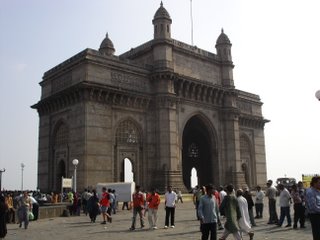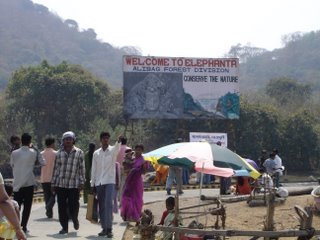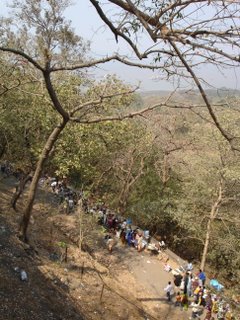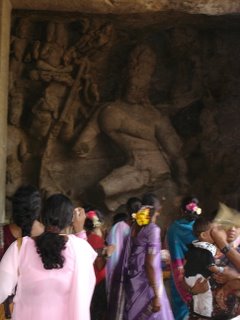Gharapuri
March 6, 2006
A week ago I decided to go to Elephanta Island to see the famous caves. The island is located in the Arabian Sea 10 kms north-east of the Gateway of India and is one of the major tourist destinations for travellers to Mumbai.
Bob had talked to several co-workers about the logistics of getting to Elephanta and we decided that it would be a grueling trip for our young children and that frankly they would probably not enjoy it. As such, Bob who is not as keen about these attractions as I am graciously agree to stay at home with the two kids while I went to Elephanta with my sister-in-law and her 14 year old son.
The trip involved a 1 hour 15 minute ferry ride from the Gateway of India to Elephanta Island and then a 2 km walk from the ferry landing point up to the caves. The walk also included a graduated 120 step climb up the Deccan mountains to reach the cave temples. Although it was still the end of February the sun scorched unforgivingly down on us and crowds of other people exploring Elephanta on this day. This excursion, which was challenging now would be excruciating in another couple of weeks time as summer blazed down on Mumbai. I got a good sense of how hot the summers could be and began to understand why most travel is recommended between October and March. Seasonally, March through June brings the hot summer, July and August brings the monsoon rains which serves to bring more humidity than cool air and the relatively cooler weather starts at the tail end of September.
Our driver, Dubey, picked me up from our flat in Bandra at 10 am and we made it to the Gateway where I was to meet my sister-in-law and nephew arriving a little before 11 am. We had made pretty good time, largely because it was a Sunday. This trip from the north suburbs of Mumbai to South Bombay could take upwards of 1 hour and 15 minutes during weekdays with bumper to bumper traffic.
 Having arrived at the Gateway with a few minutes to spare, I looked around. Although I look Indian, with my leather clogs and travel bag slung sideways across my shoulder I stood out as a Westerner as much as tourists with their platinum blond hair and cameras in tow. Within seconds I was inundated by men selling picture books and tours and had to wave them away. I walked around the pavement for a couple of minutes taking in the equal numbers of tourists and Indians who filled the area in front of the Gateway. Looking at my watch and seeing the small hand hit the 11 o’clock mark I approached an Indian couple who looked like locals, “Do you know where the Police Chowki is?” Following their pointed fingers I made my way to the police stand. I was sure that it was the right place because I could see several stalls for ferry departures to Elephanta. My sister-in-law and nephew appeared before me clad in hats and carrying a bag with water and their lunch. I kicked myself wishing that I had brought my hat as well.
Having arrived at the Gateway with a few minutes to spare, I looked around. Although I look Indian, with my leather clogs and travel bag slung sideways across my shoulder I stood out as a Westerner as much as tourists with their platinum blond hair and cameras in tow. Within seconds I was inundated by men selling picture books and tours and had to wave them away. I walked around the pavement for a couple of minutes taking in the equal numbers of tourists and Indians who filled the area in front of the Gateway. Looking at my watch and seeing the small hand hit the 11 o’clock mark I approached an Indian couple who looked like locals, “Do you know where the Police Chowki is?” Following their pointed fingers I made my way to the police stand. I was sure that it was the right place because I could see several stalls for ferry departures to Elephanta. My sister-in-law and nephew appeared before me clad in hats and carrying a bag with water and their lunch. I kicked myself wishing that I had brought my hat as well.
We purchased tickets for a ferry departing momentarily. The ticket seller managed to persuade us to spring for the more expensive luxury seats. Although initially reluctant, we were promised that the seats were much better and on a separate luxury ferry. We rushed to the Arabian Sea side of Gateway and arrived just in time to make the ferry. Other people were paying cash in front of us and I had my doubts as to whether there really was any such thing as a luxury ferry as we boarded the boat and sat on the hard plastic seats. As luck would have it we were seated on the shady side and although after a while the rolling of the waves became monotonus we passed the time chatting with each other.
 We finally docked at the ferry landing. It didn’t take long to discern that tourism had arrived with a vengeance to Elephanta Island. Along the 2 km trapse from the jetty to the caves we passed stalls selling water, cool beverages, hats, tour books, and men squatting on the ground sellings cheap plastic toys and various other souvenirs as well as women selling an assortment of berries. There was even a small post office for people who wished to send out postcards from the Island. Actually, it was probably to serve the needs of the several hundred people for whom the island was home. People spoke little during the strenuous trek to the caves, weathering the hot sun and fatigue
We finally docked at the ferry landing. It didn’t take long to discern that tourism had arrived with a vengeance to Elephanta Island. Along the 2 km trapse from the jetty to the caves we passed stalls selling water, cool beverages, hats, tour books, and men squatting on the ground sellings cheap plastic toys and various other souvenirs as well as women selling an assortment of berries. There was even a small post office for people who wished to send out postcards from the Island. Actually, it was probably to serve the needs of the several hundred people for whom the island was home. People spoke little during the strenuous trek to the caves, weathering the hot sun and fatigue  and conserving energy with few words. I walked on ahead while my companions followed behind. I would stop every once in a while perusing the wares that were being sold and wait for my sister-in-law and nephew to catch up. On several of these stops along the way I noticed one woman always directly ahead of them. She was an elderly woman in a sari who clutched a bag in her right hand. She stood out more for her determined expression than her pronounced limp which caused her body to dip unsymmetrically to the right with every step forward. I remember thinking that she maintained a pretty good pace for someone with a walking impediment, especially up the unevenly paved incline.
and conserving energy with few words. I walked on ahead while my companions followed behind. I would stop every once in a while perusing the wares that were being sold and wait for my sister-in-law and nephew to catch up. On several of these stops along the way I noticed one woman always directly ahead of them. She was an elderly woman in a sari who clutched a bag in her right hand. She stood out more for her determined expression than her pronounced limp which caused her body to dip unsymmetrically to the right with every step forward. I remember thinking that she maintained a pretty good pace for someone with a walking impediment, especially up the unevenly paved incline.
Others I passed included parents carrying their small children up the mountain side shielding their faces from the beating sun with hats or cloths. I was really glad that Sandrine and Nikhitita were with their father in the comfort of our flat.

We made our way to the main cave and I immediately glanced at the guide book, “Guide to Elephnata” (as it was misspelled) to try to make out the carvings that appeared in front of us. There were several inner caverns, and when I peered into these I could see that they had orange and white flowers strewn about the center. There were clearly two camps of people in the caves. Some who like me carried cameras, leafed through guide books and wore comfortable walking shoes and others like the people praying in the inner caverns who carried offerings, were barefoot, and bowed their heads reverently. I was reminded that although Elephanta Island was a tourist destination with thousands of visitors a day trampling through the caves, it was also called Gharapuri in ancient literature. Gharis were what the priests of the temple were called and puri means town. Gharipuri literally means town of the Ghari priests. This place had a religious significance to people centuries ago and it clearly has a religious meaning to people today. This was evident at the entry ways to the Siva Shrine where people had respectfully left their shoes outside in order to worship the Linga, which represents the generative power of nature and is the symbol of Siva. The determination of the elderly sari clad woman with the limp made sense to me now. Although the last time I saw the woman was at the entry path to the caves after the 120th and final step and I could never know for certain, I surmised that her motivation was religious, which must have fueled her determination. I wondered which camp the parents carrying their small children fell into. It was a gentle reminder to me to be cognizant that many of the places that we would see in India would mean more to others than just another site to cross off the “must see” list of places to experience in my lifetime.
This place had a religious significance to people centuries ago and it clearly has a religious meaning to people today. This was evident at the entry ways to the Siva Shrine where people had respectfully left their shoes outside in order to worship the Linga, which represents the generative power of nature and is the symbol of Siva. The determination of the elderly sari clad woman with the limp made sense to me now. Although the last time I saw the woman was at the entry path to the caves after the 120th and final step and I could never know for certain, I surmised that her motivation was religious, which must have fueled her determination. I wondered which camp the parents carrying their small children fell into. It was a gentle reminder to me to be cognizant that many of the places that we would see in India would mean more to others than just another site to cross off the “must see” list of places to experience in my lifetime.
A week ago I decided to go to Elephanta Island to see the famous caves. The island is located in the Arabian Sea 10 kms north-east of the Gateway of India and is one of the major tourist destinations for travellers to Mumbai.
Bob had talked to several co-workers about the logistics of getting to Elephanta and we decided that it would be a grueling trip for our young children and that frankly they would probably not enjoy it. As such, Bob who is not as keen about these attractions as I am graciously agree to stay at home with the two kids while I went to Elephanta with my sister-in-law and her 14 year old son.
The trip involved a 1 hour 15 minute ferry ride from the Gateway of India to Elephanta Island and then a 2 km walk from the ferry landing point up to the caves. The walk also included a graduated 120 step climb up the Deccan mountains to reach the cave temples. Although it was still the end of February the sun scorched unforgivingly down on us and crowds of other people exploring Elephanta on this day. This excursion, which was challenging now would be excruciating in another couple of weeks time as summer blazed down on Mumbai. I got a good sense of how hot the summers could be and began to understand why most travel is recommended between October and March. Seasonally, March through June brings the hot summer, July and August brings the monsoon rains which serves to bring more humidity than cool air and the relatively cooler weather starts at the tail end of September.
Our driver, Dubey, picked me up from our flat in Bandra at 10 am and we made it to the Gateway where I was to meet my sister-in-law and nephew arriving a little before 11 am. We had made pretty good time, largely because it was a Sunday. This trip from the north suburbs of Mumbai to South Bombay could take upwards of 1 hour and 15 minutes during weekdays with bumper to bumper traffic.
 Having arrived at the Gateway with a few minutes to spare, I looked around. Although I look Indian, with my leather clogs and travel bag slung sideways across my shoulder I stood out as a Westerner as much as tourists with their platinum blond hair and cameras in tow. Within seconds I was inundated by men selling picture books and tours and had to wave them away. I walked around the pavement for a couple of minutes taking in the equal numbers of tourists and Indians who filled the area in front of the Gateway. Looking at my watch and seeing the small hand hit the 11 o’clock mark I approached an Indian couple who looked like locals, “Do you know where the Police Chowki is?” Following their pointed fingers I made my way to the police stand. I was sure that it was the right place because I could see several stalls for ferry departures to Elephanta. My sister-in-law and nephew appeared before me clad in hats and carrying a bag with water and their lunch. I kicked myself wishing that I had brought my hat as well.
Having arrived at the Gateway with a few minutes to spare, I looked around. Although I look Indian, with my leather clogs and travel bag slung sideways across my shoulder I stood out as a Westerner as much as tourists with their platinum blond hair and cameras in tow. Within seconds I was inundated by men selling picture books and tours and had to wave them away. I walked around the pavement for a couple of minutes taking in the equal numbers of tourists and Indians who filled the area in front of the Gateway. Looking at my watch and seeing the small hand hit the 11 o’clock mark I approached an Indian couple who looked like locals, “Do you know where the Police Chowki is?” Following their pointed fingers I made my way to the police stand. I was sure that it was the right place because I could see several stalls for ferry departures to Elephanta. My sister-in-law and nephew appeared before me clad in hats and carrying a bag with water and their lunch. I kicked myself wishing that I had brought my hat as well.We purchased tickets for a ferry departing momentarily. The ticket seller managed to persuade us to spring for the more expensive luxury seats. Although initially reluctant, we were promised that the seats were much better and on a separate luxury ferry. We rushed to the Arabian Sea side of Gateway and arrived just in time to make the ferry. Other people were paying cash in front of us and I had my doubts as to whether there really was any such thing as a luxury ferry as we boarded the boat and sat on the hard plastic seats. As luck would have it we were seated on the shady side and although after a while the rolling of the waves became monotonus we passed the time chatting with each other.
 We finally docked at the ferry landing. It didn’t take long to discern that tourism had arrived with a vengeance to Elephanta Island. Along the 2 km trapse from the jetty to the caves we passed stalls selling water, cool beverages, hats, tour books, and men squatting on the ground sellings cheap plastic toys and various other souvenirs as well as women selling an assortment of berries. There was even a small post office for people who wished to send out postcards from the Island. Actually, it was probably to serve the needs of the several hundred people for whom the island was home. People spoke little during the strenuous trek to the caves, weathering the hot sun and fatigue
We finally docked at the ferry landing. It didn’t take long to discern that tourism had arrived with a vengeance to Elephanta Island. Along the 2 km trapse from the jetty to the caves we passed stalls selling water, cool beverages, hats, tour books, and men squatting on the ground sellings cheap plastic toys and various other souvenirs as well as women selling an assortment of berries. There was even a small post office for people who wished to send out postcards from the Island. Actually, it was probably to serve the needs of the several hundred people for whom the island was home. People spoke little during the strenuous trek to the caves, weathering the hot sun and fatigue  and conserving energy with few words. I walked on ahead while my companions followed behind. I would stop every once in a while perusing the wares that were being sold and wait for my sister-in-law and nephew to catch up. On several of these stops along the way I noticed one woman always directly ahead of them. She was an elderly woman in a sari who clutched a bag in her right hand. She stood out more for her determined expression than her pronounced limp which caused her body to dip unsymmetrically to the right with every step forward. I remember thinking that she maintained a pretty good pace for someone with a walking impediment, especially up the unevenly paved incline.
and conserving energy with few words. I walked on ahead while my companions followed behind. I would stop every once in a while perusing the wares that were being sold and wait for my sister-in-law and nephew to catch up. On several of these stops along the way I noticed one woman always directly ahead of them. She was an elderly woman in a sari who clutched a bag in her right hand. She stood out more for her determined expression than her pronounced limp which caused her body to dip unsymmetrically to the right with every step forward. I remember thinking that she maintained a pretty good pace for someone with a walking impediment, especially up the unevenly paved incline.Others I passed included parents carrying their small children up the mountain side shielding their faces from the beating sun with hats or cloths. I was really glad that Sandrine and Nikhitita were with their father in the comfort of our flat.

We made our way to the main cave and I immediately glanced at the guide book, “Guide to Elephnata” (as it was misspelled) to try to make out the carvings that appeared in front of us. There were several inner caverns, and when I peered into these I could see that they had orange and white flowers strewn about the center. There were clearly two camps of people in the caves. Some who like me carried cameras, leafed through guide books and wore comfortable walking shoes and others like the people praying in the inner caverns who carried offerings, were barefoot, and bowed their heads reverently. I was reminded that although Elephanta Island was a tourist destination with thousands of visitors a day trampling through the caves, it was also called Gharapuri in ancient literature. Gharis were what the priests of the temple were called and puri means town. Gharipuri literally means town of the Ghari priests.
 This place had a religious significance to people centuries ago and it clearly has a religious meaning to people today. This was evident at the entry ways to the Siva Shrine where people had respectfully left their shoes outside in order to worship the Linga, which represents the generative power of nature and is the symbol of Siva. The determination of the elderly sari clad woman with the limp made sense to me now. Although the last time I saw the woman was at the entry path to the caves after the 120th and final step and I could never know for certain, I surmised that her motivation was religious, which must have fueled her determination. I wondered which camp the parents carrying their small children fell into. It was a gentle reminder to me to be cognizant that many of the places that we would see in India would mean more to others than just another site to cross off the “must see” list of places to experience in my lifetime.
This place had a religious significance to people centuries ago and it clearly has a religious meaning to people today. This was evident at the entry ways to the Siva Shrine where people had respectfully left their shoes outside in order to worship the Linga, which represents the generative power of nature and is the symbol of Siva. The determination of the elderly sari clad woman with the limp made sense to me now. Although the last time I saw the woman was at the entry path to the caves after the 120th and final step and I could never know for certain, I surmised that her motivation was religious, which must have fueled her determination. I wondered which camp the parents carrying their small children fell into. It was a gentle reminder to me to be cognizant that many of the places that we would see in India would mean more to others than just another site to cross off the “must see” list of places to experience in my lifetime.


0 Comments:
Post a Comment
<< Home